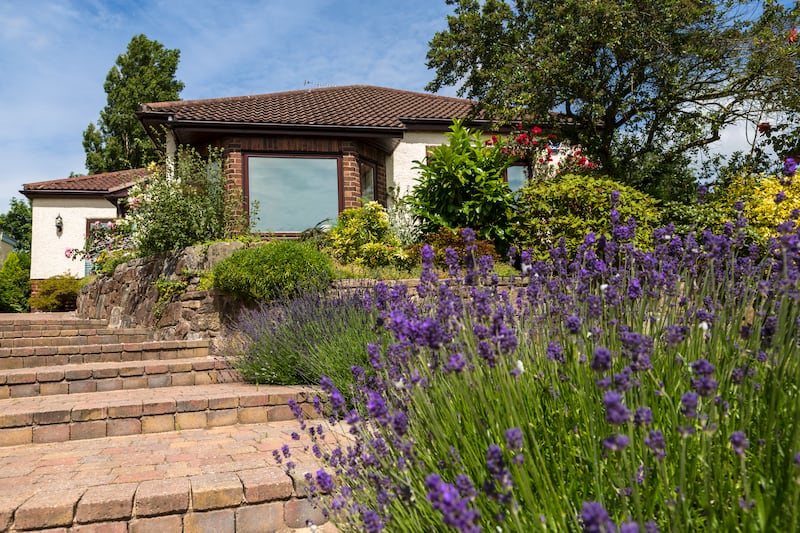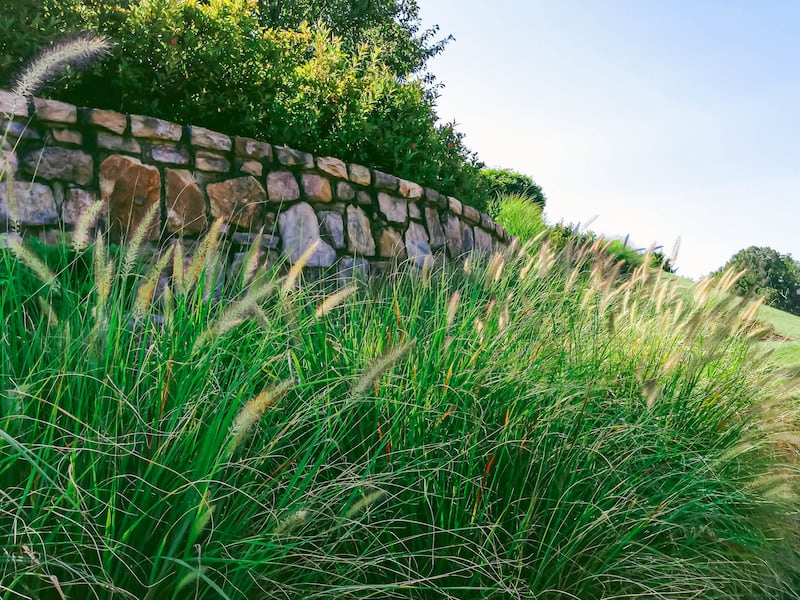When it comes to the challenges of making a garden, a level playing field is never guaranteed. In particular, it’s fair to say that those of us faced with sloping banks – a common feature of many Irish gardens – have it particularly hard.
Banks are notoriously tricky to plant well for many reasons. Their steep camber means that rain and groundwater run swiftly along the surface, regularly washing away soil, mulches and nutrients while simultaneously splashing water back on to leaves and stems. As for the soil itself, it’s usually of poor quality, typically a nasty hotchpotch of subsoil and topsoil tossed together during building works. As a result, it can dry out to a stiff crust in summer, making healthy plant growth difficult and routine maintenance challenging.
Banks situated close to houses are also vulnerable to wind tunnels, a result of the wind abruptly changing speed and direction when it smacks up against buildings or high walls. This then causes it to be sharply funnelled through the narrow spaces between a house and its surrounding banks (the direction of least resistance), typically creating a hostile growing environment that’s considerably colder and windier than other parts of the garden.
The common result of all this is an unhappy mishmash of dead, damaged or stunted plants, messy weed growth and ugly weed-suppressant membrane exposed nakedly to the elements. Tall, shallow-rooting species, for example, tend to quickly topple. The foliage of large evergreens can get scorched while deciduous shrubby species in particular can be badly chilled by icy winds, especially in early spring as they break into bud.
READ MORE

Their sharply sloping surfaces also make it next to impossible to maintain steep banks as a conventional lawn. Few of us have the time or energy for the acrobatics required to manage them with a lawnmower or strimmer and even if we did, it’s generally not safe to do so. The alternative sometimes suggested is to treat them as a place where wild grasses and wildflowers can be encouraged to take a foothold. But the uncomfortable truth is this can quickly look unkempt while it also presents similar challenges as regards upkeep.
What to do? If and when budget allows, a good solution is to start by breaking that steeply banked surface up into a series of shallower, much more manageable terraces retained by low walls, gabions or timber, and incorporating easy access in the shape of well-built steps and/or ramps. These should be constructed out of solid, durable materials and with an understanding of the recommended width and height of the treads and risers, ideally allowing a measurement of about 30cm for the former and 15cm for the latter, as mentioned in last week’s column. With ramps, a slope gradient of no more than 1:12 is important to ensure they are easily navigable.
This sort of costly hard landscaping isn’t always an option, in which case the choice of plants is all the more important. Low, creeping evergreen species should be your go-to here, using a high proportion of hardy, resilient, tough-as-nails plants. One helpful clue to their suitability often lies in their Latin names, where the use of the words repens, reptans, prostratus, horizontalis and procumbens all indicate a low, trailing or carpeting growth habit.
Examples include bugle or Ajuga reptans, a resilient, versatile, hardy evergreen perennial tolerant of deep shade and full sun but is best in light shade. Its pretty spikes of lavender-violet, pollinator-friendly flowers are produced in spring but its ability to colonise rough, sloping ground is its greatest strength, earning it the popular description of “bomb proof”. Another is the shade-loving Mahonia repens, the creeping form of the evergreen shrub known as Oregon grape or barberry. Reaching a height of just 30cm and tolerant of a wide range of soils, it forms a low, dense carpet of spiny evergreen foliage, above which its dense clusters of yellow flowers appear in late spring.

Other evergreen plants suitable for a shady bank include varieties of both the greater periwinkle (Vinca major) and lesser periwinkle (Vinca minor), both of which make excellent carpeting ground cover; Pachysandra terminalis; the pretty bellflower Campanula portenschagiana; many species of Epimedium including Epimedium epigerum and Epimedium perallchicum; clump-forming elephant’s ears (Bergenia); and spurge (Euphorbia amydaloides robbiae).
For a sunny bank in milder parts of the country, try creeping blue blossom (Ceanothus thyrsiflorus var repens), a low-growing, mound-forming, evergreen shrub with clouds of small blue flowers in late spring-early summer. Another blue-flowered, low-growing evergreen species for a sunny bank is Glandora prostrata (formerly known as Lithiodora diffusa), but only in humus-rich, acidic soils. Other acid-loving, sun-loving species up to the job include heather (Calluna vulgaris); checkerberry (Gaultheria shallon); and creeping juniper (Juniperus horizontalis), which is also happy in neutral and alkaline soils.
For a hot, dry bank in full sun, choose drought-tolerant species that can cope with the particularly harsh growing challenges this presents. Examples include rock rose (species of Cistus and Helianthemum); the dainty, daisy-flowered Mexican fleabane (Erigeron karvinskianus); various species of Acaena including Acaena inermis, Acaena saccaticupula and Acaena affinis; the fluffy, grey-leaved Lamb’s ear (Stachys byzantina); creeping thyme (Thymus serphyllus); wall germander (Teucrium chamaedrys); and rockcress (Arabis procurrens).
To ring in the seasonal changes, incorporate some areas of planting using deciduous perennial and shrubby species. Suitable examples include varieties of ground cover roses (recommended varieties include any from the “Flower Carpet” series and the “County Collection”); long-flowering varieties of perennial geranium such as Rozanne; creeping varieties of bellflower such as Campanula poscharskyana and Campanula carpatica; the wonder plant that is lady’s mantle (Alchemilla mollis); the ever-elegant ornamental grass known as Hakonechloa macra; and the low-growing Cotoneaster horizontalis whose tiny pale flowers are beloved by bees.
Left to their own devices, many (but not all) of the above have a somewhat thuggish growth habit that can make them challenging to control when cultivated in the best of growing conditions, but which is their great strength when planted in difficult terrain. For best effect as well as ease of maintenance, plant them en-masse in large groupings and more closely together than traditionally recommended. In this way they’ll quickly form a dense carpet of weed-suppressant growth that will also help protect the soil from erosion, making them the perfect nature-friendly solution in many more ways than one.
This Week in the Garden
- Keep an eye out for self-sown seedlings of perennials and dig them up and pot them on for replanting into their permanent positions/giving to gardening friends/donating to a plant sale, or mark their position with a discreet label to avoid accidentally digging them up later in the year.
- Cut and dry fresh herbs or freeze some leaves in ice cube trays for use later in the year, both of which are great ways to preserve their delicious home-grown flavour for use in the cold dark months of winter.
- Dates For Your Diary: Today is the final day of Carlow Garden Festival 2024 with talks by Paul Smyth at the Barrow Experience Gardens, BEAM Centre (11am) and Patrick Hunt at Rath Wood Forest (3pm): see carlowgardentrail.com for full details, pre-booking advisable.

















